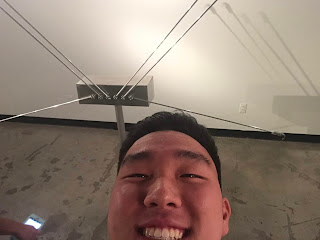I was explained about this artwork, which is displayed below, by artist Sarah Brady herself at the exhibition and with a more thorough explanation at the LASER event which I went to right after visiting this exhibit. Essentially, I first described this artwork as what appeared to be half of a unit circle, connecting it to the math, specifically geometry, and art unit we had towards the beginning of the year. However, after hearing the explanation about what exactly it represented, I was thoroughly impressed and intrigued by the meaning behind this piece of work. The piece of artwork displayed six eagles’ talons, which would be spread out evenly at one point and then switch to a different position. This change in position was because of what was described as a “defense mechanism” in terms of the eagle metaphor (Brady). Her goal to make technohybrid forms in her artwork brings back memories of many units in our class where we examined how technology and art come together. Similarly, Brady incorporates technology in order to display the behaviors of eagles, which include guarding, shielding, and even thinking on its own (Brady).
(The first time I saw this art piece at the Thesis Show held at Broad Art Center)
(The second time I saw the art piece, except at the Coyotes in Two Directions exhibition)
Another interesting piece of artwork artist Sarah Brady set up in her exhibit was the two metal rods with coyote feet on both sides of the rod. The coyote feet on the top and bottom of the rod signify exactly what her exhibition’s name is: Coyote in Two Directions. Furthermore, coyotes are actually thought of as one of the most successful animals to survive the Anthropocece and in fact have a deeply symbolic and mythological presence in this piece of art. The two coyote feet essentially represent the way coyotes roam around in these “two directions," towards the heavens and below. The coyote feet in this display were actually 3D printed, which once again depicts how technology plays a big role in art, especially in this time and age (Redwood).
(A selfie with an art piece with two coyote paws)
(Another art piece by Sarah Rosalena Brady displaying a 3D printed rattlesnake tail)
Overall, this was a very interesting exhibition and I would recommend for anyone looking to see how technology and art come together to form a distinct artform.
References
Brady , Sarah Rosalena. “The Desert, The Animist, The Virus.” Sarah Rosalena Brady | Artist Website, www.srbrady.com/the-desert-the-animist-the-virus.
“COYOTES IN TWO DIRECTIONS.” COLLECTIVE BREAD DIARIES: A TASTE OF PROTEST | UCLA Art | Sci Center Lab, artsci.ucla.edu/node/1395.
“JUNE 7: LEONARDO ART SCIENCE EVENING RENDEZVOUS (LASER).” YouTube, CNSI at UCLA, 7 June 2018, www.youtube.com/watch?time_continue=1340.
Redwood , Ben. “The Advantages of 3D Printing.” 3D Hubs, 3D Hubs Blog, www.3dhubs.com/knowledge-base/advantages-3d-printing.
Sanders, Robert E. “Technology Innovation in Aluminum Products.” Raising the Hunley: Archaeology Meets Technology, www.tms.org/pubs/journals/JOM/0102/Sanders-0102.html.















